Tom's Hardware Verdict
The AOC C32G2ZE is an excellent monitor in every way except pixel density. With great contrast, color and gaming performance, it delivers responsive play. But its low pixel density means that it’s too easy to make out the pixel structure unless you sit far away.
Pros
- +
+ Excellent contrast
- +
+ Accurate color with calibration
- +
+ Solid video processing
- +
+ Strong build quality
Cons
- -
Low pixel density
- -
No HDR
Why you can trust Tom's Hardware
There are many elements of a monitor’s performance that impact your gaming experience. Speed and responsiveness are certainly at the top of the list but image quality, both static and moving, is just as important. Many gamers differentiate displays by resolution, and that’s where we must consider the balance between the PC’s graphics processing power and the number of pixels it must move about the screen.
We’ve reviewed plenty of 1080p (1920x1080) monitors in 25 and 27-inch sizes and found them solid performers. Some run at 240 and even 360 Hz, allowing for very high frame rates. Obviously, this makes motion resolution much better. But when pixel density enters the discussion, how big is too big?
The AOC C32G2ZE seeks to answer that question with a 32-inch, curved, 1080p VA panel. It runs at 240 Hz and supports AMD FreeSync Premium. You get DCI-P3 color but no HDR; however, there are HDR emulation modes available.
There is no doubt that the C32G2ZE is well-focused on gameplay. It also sports decent build quality and is $330 as of writing. So, everything one needs in a gaming monitor is there except for pixel density. Can this giant, 1080p screen compete with the best gaming monitors?
AOC C32G2ZE Specifications
| Panel Type / Backlight | VA / W-LED, edge array |
| Screen Size / Aspect Ratio | 31.5 inches / 16:9 |
| Row 2 - Cell 0 | Curve radius: 1800mm |
| Max Resolution & Refresh | 1920 x 1080 @ 240 Hz |
| Row 4 - Cell 0 | FreeSync Premium: 48-240 Hz |
| Native Color Depth & Gamut | 8-bit / DCI-P3 |
| Response Time (GTG) | 1ms |
| Brightness | 300 nits |
| Contrast | 4,000:1 |
| Speakers | None |
| Video Inputs | 1x DisplayPort 1.2 |
| Row 11 - Cell 0 | 2x HDMI 2.0 |
| Audio | 3.5mm headphone output |
| USB 3.0 | None |
| Power Consumption | 22w, brightness @ 200 nits |
| Panel Dimensions WxHxD w/base | 27.9 x 20.5 x 9.8 inches (709 x 521 x 249mm) |
| Panel Thickness | 3.3 inches (85mm) |
| Bezel Width | Top/sides: 0.3 inch (7mm) |
| Row 18 - Cell 0 | Bottom: 0.9 inch (23mm) |
| Weight | 15.4 pounds (7kg) |
| Warranty | 3 years |
The AOC C32G2ZE is unusual. We looked back at our complete monitor review database and could not find a single FHD display larger than 27 inches. That means this AOC’s pixel density is 69 pixels per inch (ppi), compared to our preferred sweet spot of 109ppi. The C32G2ZE is comparable to a 4K resolution, 65-inch TV (68ppi). But you’ll be sitting 3-4 feet away from the C32G2ZE.
The upside is, of course, gaming performance. The C32G2ZE runs at 240 Hz and can hit its maximum speed without requiring an expensive video card. It supports AMD FreeSync Premium down to 48 Hz with low framerate compensation (LFC), so you’ll never see a frame tear. We were also able to run Nvidia G-Sync on it without certification (see How to Run G-Sync on a FreeSync Monitor). The monitors adds a decent overdrive too, which keeps motion blur to a minimum.
Assembly and Accessories of AOC C32G2ZE
The C32G2ZE arrives in three pieces – base, upright and panel. You don't need any tools to assemble it, and the finished unit is very solid, yet lighter than its size would suggest.
Get Tom's Hardware's best news and in-depth reviews, straight to your inbox.
AOC's monitor includes HDMI and DisplayPort cables (see DisplayPort vs HDMI), plus an IEC cord for the internal power supply.
Product 360: AOC C32G2ZE
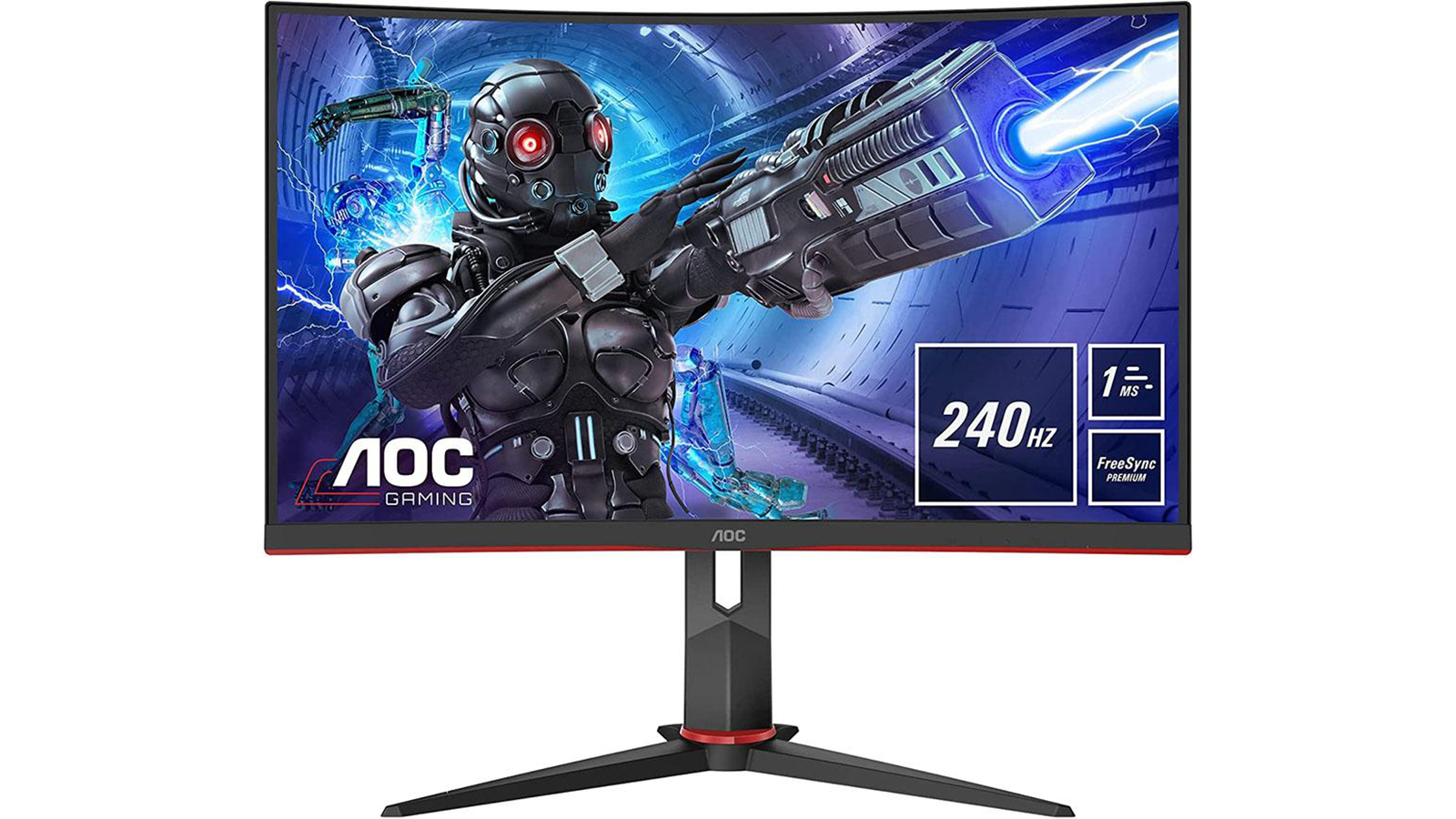
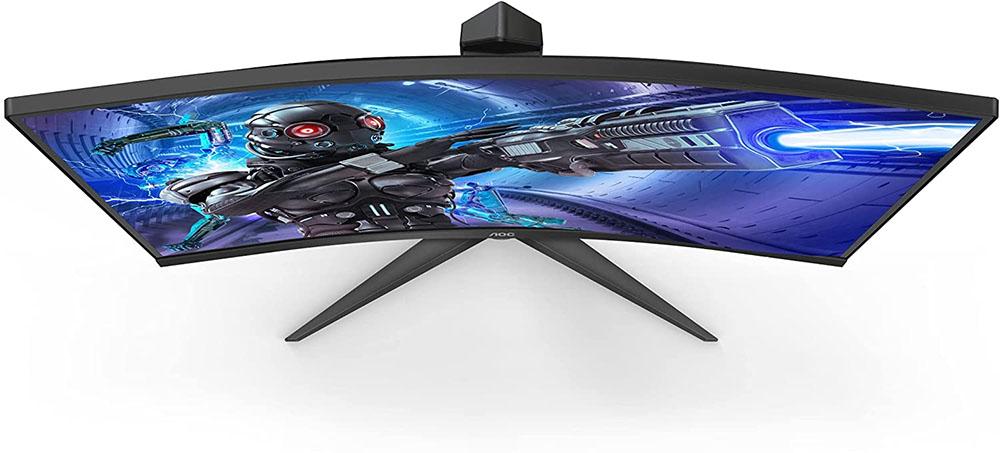
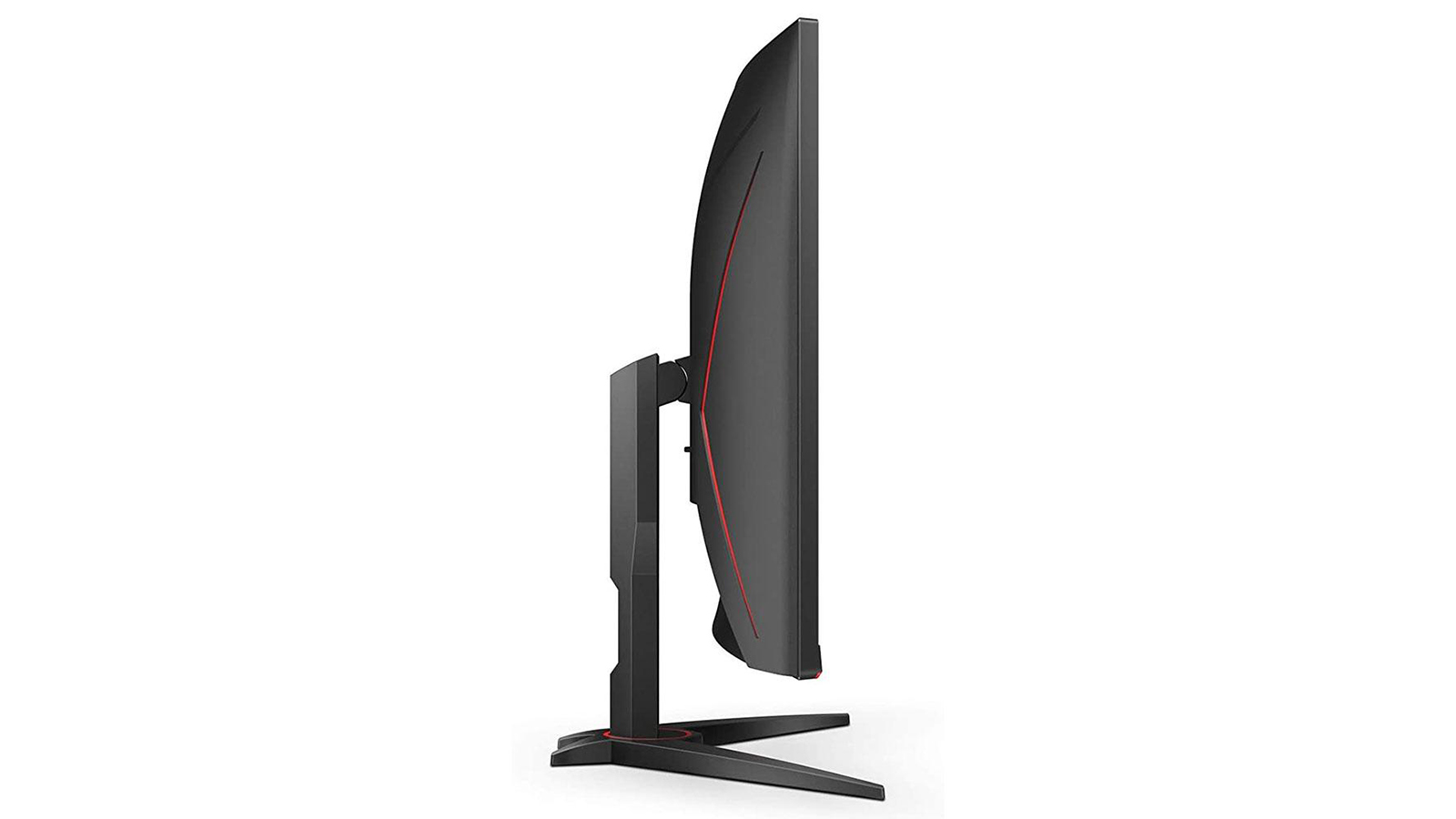
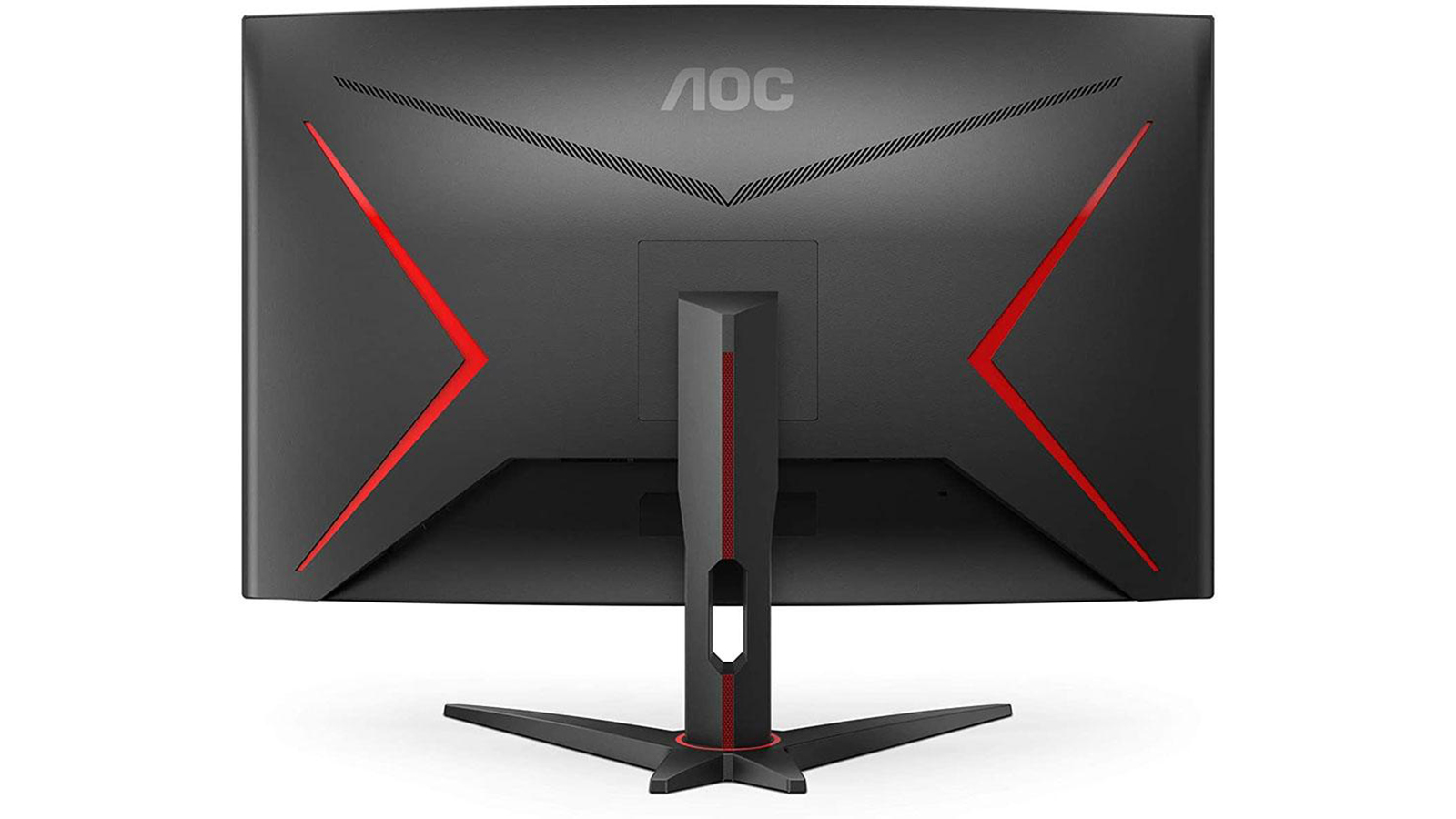
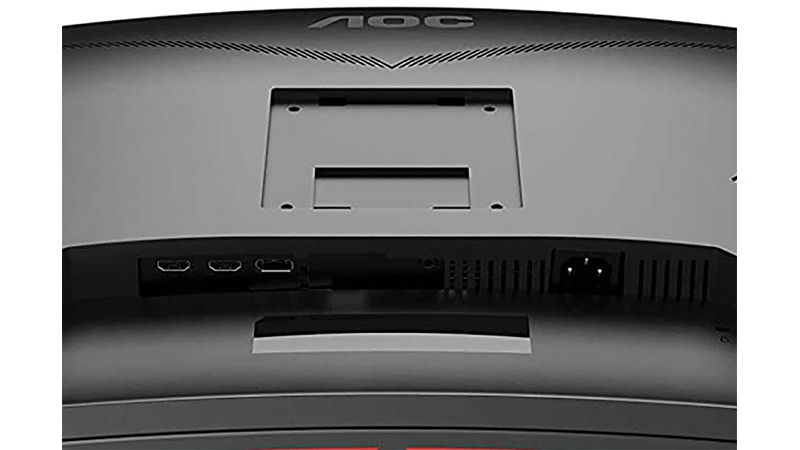
The front bezel on the AOC C32G2ZE is very thin, just 7mm, and flush mounted. It disappears when there is no image present. The bottom strip is 23mm wide with a small AOC logo and a bit of red trim. A closer look reveals a subtle facet effect along the bottom edge, something we haven't seen before. The red accent is repeated where the base attaches to the upright. That part has a handy cable hole to keep your wiring tidy.
The stand has no adjustments except for -3.5/21.5 degrees of tilt. It sits at a good height for the average desktop, and we were able to keep it perfectly vertical for gaming, which is the best way to take advantage of the 1800R curvature.
Around back are more of the red accents. The two chevrons in the photo appear to be lit, but they are just reflective. The AOC C32G2ZE does not have RGB.
You can remove the upright to reveal a 100mm VESA mount for which you’ll have to provide your own fasteners. A stylish grill keeps the internal components cool with no need for a fan.
The AOC C32G2ZE does not have built-in speakers, but sound is carried over the HDMI and DisplayPort connections to a 3.5mm audio port into which you can plug your best gaming headset or powered speakers. The two HDMI ports are version 2.0, while the single DisplayPort is 1.2. All support Adaptive-Sync, but you’ll need DisplayPort for the full 240 Hz.
OSD Features of AOC C32G2ZE
The C32G2ZE’s on-screen display (OSD) is AOC’s familiar ribbon-style menu that appears across the bottom of the screen. We missed the joysticks that come with many gaming monitors and had to settle for a set of control keys. It became intuitive after a time, but the joystick is still better and faster.
The OSD is divided into six sub-menus.
In the Luminance menu, you get brightness and contrast of course, along with seven picture modes, three gamma presets, dynamic contrast and the three HDR emulation modes. The AOC C32G2ZE does not accept HDR signals but attempts to simulate the effect with three HDR modes called Picture, Game and Movie. None truly replicate the look of HDR but may appeal to some. Luminance and color controls are grayed out in these modes, so you can’t tweak them. However, they aren’t really necessary because the VA panel’s high contrast delivers a very dynamic picture on its own.
In the Color Setup menu, you’ll find three color temp presets, plus an sRGB mode, which properly changes the native DCI-P3 gamut to the sRGB standard. We’ll show you its metrics on page 3. If you select the user mode, the RGB sliders are very precise, allowing us to achieve high accuracy.
In the Game Setting menu, you can brighten shadow detail if you have a hard time seeing into dark areas of the image. This is certainly a factor when playing on a monitor with deep black levels like the AOC C32G2ZE.
You can also increase color saturation, engage a low blue light mode, adjust the overdrive level (medium is best), toggle Adaptive-Sync and turn on a framerate indicator. If you turn off FreeSync Premium/Adaptive-Sync, a blur reduction backlight strobe becomes active. It has adjustable pulse width, so you can balance blur reduction and brightness. Less blur also means less light. We found it didn’t make moving images any smoother. 240 Hz does that just fine with Adaptive-Sync on.
AOC C32G2ZE Calibration Settings
The AOC C32G2ZE comes out of the box in its Standard mode. It has a few minor flaws and should be calibrated for the best possible picture.
Grayscale is a tad too red, and the gamma is too light. A few changes to the RGB sliders and a switch from Gamma 1 to Gamma 3 resolves those issues.
This is one of the highest contrast monitors we’ve tested, and our tweaks made the picture very rich and textural with no need for the dynamic contrast feature.
We do not recommend using the HDR emulation modes, because they do not make the image better. We’ll show you their effects on color and gamma on page 3.
Below are our recommended calibration settings for the AOC C32G2ZE.
| Picture Mode | Standard |
| Brightness 200 nits | 70 (min. 137 nits) |
| Contrast | 47 |
| Gamma | 3 |
| Color Temp User | Red 47, Green 50, Blue 52 |
Gaming and Hands-on with AOC C32G2ZE
The AOC C32G2ZE presents an interesting conundrum. On one hand, its color accuracy and contrast make it very attractive. But with a pixel density of just 67ppi, you can't help but see the pixel structure at a 3-4 foot viewing distance. We spent quite a bit of time exploring games, videos and static images to see how this unique monitor performed under real world conditions.
With font scaling set to 100%, text was perfectly readable though not as sharply defined as a smaller monitor would be. We had no trouble reading news articles or working in productivity apps. But text was a tad softer than we’re accustomed to. Small icons looked well-defined if a little less crisp than normal.
We had no complaints about color or contrast though. Both are first-rate. Black levels looked very deep, making the picture pop. There’s plenty of brightness available too if you need to turn up the image in a brightly lit room. Color saturation made watching YouTube videos a pleasure. The extra contrast had a positive effect making color vibrant but not harsh.
When gaming, the AOC C32G2ZE wasn't as sharp during action games as a higher-res screen but delivered great contrast and color in all situations, and that made details stand out. In Doom Eternal the game's hellish scenery was fiery and red with good texturing. Mowing down enemies was satisfying too as their bits flew all over the screen.
Call of Duty: WWII was much the same with a good sense of realism. Characters' faces were clear and naturally hued. Outdoor scenes were rendered with excellent contrast. Highlights like metallic reflections and beads of sweat stood out strongly. Color was also quite vivid in this game. With lots of earth tones and subtle shades of green making up the image, we felt a good suspension of disbelief.
Video processing worked without issue. At 1080p, we had no problem maxing frame rates at 240 frames per second (fps). There was rarely a change in refresh, according to the AOC C32G2ZE’s on-screen frame counter. Visually, we never saw a frame tear or any hesitation. Input lag couldn't be perceived.
The only indicator of the monitor’s low pixel density was a slight softness during fast moving action. This wasn't due to LCD motion blur or any problem with the monitor’s overdrive. Rather, it was the effect of the visible pixel structure. This is something of a subjective observation. It will be perceived differently by different players depending on how close they sit to the screen and how sharp their vision is. It was never a distraction for us though.
Despite its flaw, the AOC C32G2ZE’s large size and, more specifically, extra height really helped draw us into the gaming environment.

Christian Eberle is a Contributing Editor for Tom's Hardware US. He's a veteran reviewer of A/V equipment, specializing in monitors. Christian began his obsession with tech when he built his first PC in 1991, a 286 running DOS 3.0 at a blazing 12MHz. In 2006, he undertook training from the Imaging Science Foundation in video calibration and testing and thus started a passion for precise imaging that persists to this day. He is also a professional musician with a degree from the New England Conservatory as a classical bassoonist which he used to good effect as a performer with the West Point Army Band from 1987 to 2013. He enjoys watching movies and listening to high-end audio in his custom-built home theater and can be seen riding trails near his home on a race-ready ICE VTX recumbent trike. Christian enjoys the endless summer in Florida where he lives with his wife and Chihuahua and plays with orchestras around the state.


